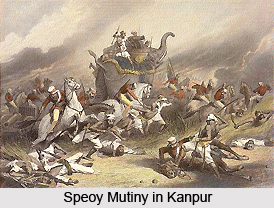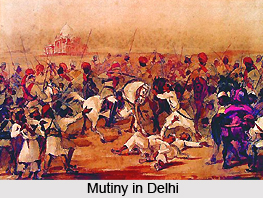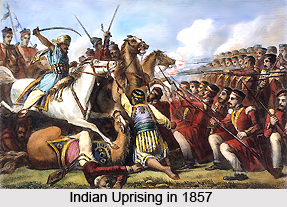 Sepoy Mutiny in India spread in different areas like Uttar Pradesh, Kanpur and some parts of the country.
Sepoy Mutiny in India spread in different areas like Uttar Pradesh, Kanpur and some parts of the country.
Siege of Kanpur
The extensive stretch between Agra and Kanpur was a huge annoyance to the British Governor-General. The native rebels had already plundered much in various other states. Agra had already been accomplished under the fit guidance of Sir Colin Campbell, Greathed, Hope Grant and General Wilson. The victory however, did come with a price; several officers and British lives were lost. With clandestine measures adopted by Greathed, the troops made victory possible in the dead of the night. Although, worried still lay in the near distance. Kanpur was yet to be occupied, and the mutinied soldiers posted there were a source of botheration.
 Siege of Agra
Siege of Agra
No sooner had the siege of Delhi been thoroughly assured than Wilson despatched a corps of 2790 men, under the command of Colonel Edward Greathed of the 8th foot, to open the country between Delhi and Agra. The corps was also ordered to join Sir Colin Campbell at Kanhpur (Kanpur, Uttar Pradesh) or its vicinity. Greathed set out on the morning of 24th September, crossed the Hindan, and marched, by way of Dadri and Sikandarabad, to Bulandshahr. On his way, he punished the inhabitants proved to have committed barbarities and reassuring those who had remained loyal. He arrived in Bulandshahr on the 28th. There, Greathed attacked and completely defeated a rebel force which attempted to cover that town. Then pushing on, he occupied the town and Malagarh. While destroying the fortifications of the latter he had the misfortune of accidentally losing Lieutenant Home of the Engineers. Home was one of the survivors of the gallant men who had blown up the Kashmeri gate on the 14th. From there, still pushing on, Greathed reached Khurja, a considerable town. Here the passions of the troops were roused to severe fury by the sight of the skeleton of a European female. The troops were contemplating taking instant vengeance on the inhabitants. But, Greathed spared Khurja in deference to the remonstrances of the civil officer accompanying the force.
Siege of Delhi
Delhi was the hotseat of rebellious and insurrectional operations both on behalf of the native and British side. The city had already been prepared as a fortification, guarding it from every possible angle. Chief Engineer of the British, Baird-Smith had devised out a plan, because he hated to wait for further delay. He had already consulted with General Wilson about his proposed plan. However, Wilson was not willing to proceed with the issue, without the strict affirmation from the Governor-General Lord Canning. Finally, after Smith had pacified Wilson saying that the loyal Sikhs could not be bound much longer, the urgency of the situation dawned upon Wilson. The rebels had already started to attack their bastioned ridge and fort. Baird-Smith, in coalition with his second command, Alexander Taylor had decided to attack the assaulters from the northern face of Delhi.
 The engineers worked untiringly with much energy at these sections. On the morning of the 8th, while still unfinished, and mounting but one gun, the enemy discovered Brind`s section. They opened upon it a fire so concentrated and so relentless that to venture from its protection was to invite almost certain death. A little later the rebels tried to improve the opportunity by despatching a body of infantry and cavalry from the Lahore gate. This diversion really privileged the English. For, while it lasted, the men in the new battery worked with such a will that they succeeded in finishing five platforms. As each platform was completed, the gun mounted on it opened against the enemy. The sortie, which had thus given badly-needed time to the defenders, was beaten back with loss. The first section of No. 1 battery had no sooner been completed than its fire, well directed by the energetic Brind, rendered the Mori bastion harmless. The gallant Kaye also had done his work with tremendous zeal. The fire directed from the left section had done good work against the Kashmir bastion. At noon of the 10th, the half-battery caught fire from the constant discharge of the guns. For a moment or two it seemed that the hard work of the three previous days would be thrown away. The rebels had at once directed on the burning battery every gun they could command.
The engineers worked untiringly with much energy at these sections. On the morning of the 8th, while still unfinished, and mounting but one gun, the enemy discovered Brind`s section. They opened upon it a fire so concentrated and so relentless that to venture from its protection was to invite almost certain death. A little later the rebels tried to improve the opportunity by despatching a body of infantry and cavalry from the Lahore gate. This diversion really privileged the English. For, while it lasted, the men in the new battery worked with such a will that they succeeded in finishing five platforms. As each platform was completed, the gun mounted on it opened against the enemy. The sortie, which had thus given badly-needed time to the defenders, was beaten back with loss. The first section of No. 1 battery had no sooner been completed than its fire, well directed by the energetic Brind, rendered the Mori bastion harmless. The gallant Kaye also had done his work with tremendous zeal. The fire directed from the left section had done good work against the Kashmir bastion. At noon of the 10th, the half-battery caught fire from the constant discharge of the guns. For a moment or two it seemed that the hard work of the three previous days would be thrown away. The rebels had at once directed on the burning battery every gun they could command.
Siege Of Lucknow
The city of Lakhnao (Lucknow) stretches, in an irregular form, on the right bank of the Gomti River. Lucknow was the seat of prime importance during the ongoing sieges of Sepoy Mutiny of 1857.
Indian Sepoy Mutiny in Meerut and Rohilkhand
In Mirath (Meerut) and the adjoining districts to the east, the treason of British authority had not been so complete as might have been expected. In Mirath (Meerut) itself authority had soon been restored. And, by the splendid energy displayed by Dunlop, by Brand Sapte, and others, successful attempts were made to re-establish the British power in the villages near it. In June the energetic Magistrate, Wallace Dunlop, had organised a troop of volunteers. It composed of officers without regiments, of members of the Civil Service, and of others who happened to be at Mirath (Meerut). Major Williams, Captain Charles D`Oyley, and Captain Tyrrhitt occupied the positions of commandant, second in command, and adjutant respectively. The officers were styled from the colour of the uniform adopted, the Khaki Risala. This troop, from the end of June to the fall of Dehli scoured the country, retook villages, punished marauders, and did all that was possible to restore and to maintain tranquillity. The Risala was often assisted by regular troops, cavalry as well as infantry.



















